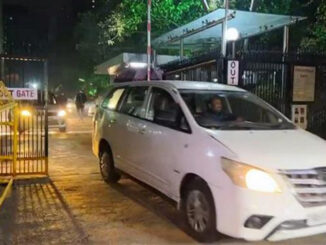
Governance has become irrelevant to win a popular mandate

“The expanse of the violence, from the east to the west and the north, confirmed three perceptions: it was pre-planned, because in each case, the trajectory pursued the same path. RSS-aligned Hindu activists went on shobha yatras that wound through Muslim localities, got uncontrollable when they passed a mosque or sighted a gathering and seemed to have provoked a reaction from Muslims (stone-pelting was reported almost everywhere). Reports suggest in places it was difficult to tell who cast the first stone. The police, though present, were said to be passive. The MP Police, though, came down strong on Muslims who allegedly instigated clashes and flattened out their properties with bulldozers, borrowed from UP’s manual.”
Henceforward every Hindu festival might be anticipated with dread and not joyousness if the trail of violence, death and destruction left behind by the processions to ‘celebrate’ Ram Navami, and earlier Nav Samvatsar (the Hindu New Year) is a portent.
Ram Navami is one among the myriad festivals dotting the Hindu calendar. It is generally observed in the quietude of a puja room in a home following a nine-day Navratri, a period of fasting and praying in North India. It is a reflection on Hinduism’s plurality that Navratri has a different connotation in southern India. It coincides with Dasehra and is signified by nine days of uninterrupted festivity intended to engage and entertain children. There is no one New Year in Hinduism; in fact, there are a dozen across the regions, depending on whether the solar or lunar calendar is followed. The New Year ushered in on April 2 is known as Gudi Padwa in Maharashtra and Goa and Ugadi in Karnataka, Andhra Pradesh and Telangana.
However, Rajasthan — which triggered the latest cycle of violence —observes its New Year on Diwali. This didn’t deter members of the Vishwa Hindu Parishad (VHP), Bajrang Dal (BD) and Vidya Bharti, the RSS’s education wing — sweepingly classified as the ‘Hindu fringe’— from launching a Nav Samvatsar shobha yatra on motorbikes at Karauli. From all accounts, the yatra acquired the color and shape of a carnival rather than a religious occasion. The participants, young men sporting the VHP’s emblematic saffron ‘bandana’, danced to songs played at full blast when they passed a mosque. According to a report in Scroll.in, some numbers were singing VHP anthems, dating back to the Ayodhya era, with the refrain, ‘khaula khoon mera’ (my blood boils), denoting that the day this happened, you (meaning Muslims) will be put in your place and the sword will speak instead of a Hindu’s words. The tropes that figured in the songs were a topi or skullcap and ‘Hindu awakening’. The report quoted young Hindus (unemployed or engaged in semi-skilled work) saying the VHP’s ditties were as inspiring as ‘Vande Mataram’ and caused goosebumps because of lines like ‘those who wear the topi will have to bend and say Jai Shri Ram’. It no longer matters which party rules a state. Rajasthan has a Congress government, rickety from day one. This round of rampage also scorched non-BJP states like Jharkhand and West Bengal and raised a question on whether the local intelligence failed to foresee the mayhem or deliberately kept quiet. Among the BJP-ruled states, Madhya Pradesh was the worst hit.
Delhi BJP leader Kapil Mishra’s infamy precedes him. He is known to give incendiary speeches that polarize communities as he did before the 2020 Delhi violence. He was in MP’s Khargone, the center of the trouble, a day before it erupted. He shared a photo captioned, ‘Neither Musa nor Burhan, only Jai Jai Shri Ram’. The names were those of Burhan Wani and Zakir Musa, Kashmir’s militants, who were eliminated by security forces.
The expanse of the violence, from the east to the west and the north, confirmed three perceptions: it was pre-planned, because in each case, the trajectory pursued the same path. RSS-aligned Hindu activists went on shobha yatras that wound through Muslim localities, got uncontrollable when they passed a mosque or sighted a gathering and seemed to have provoked a reaction from Muslims (stone-pelting was reported almost everywhere). Reports suggest in places it was difficult to tell who cast the first stone. The police, though present, were said to be passive. The MP Police, though, came down strong on Muslims who allegedly instigated clashes and flattened out their properties with bulldozers, borrowed from UP’s manual.
The yatris were armed with swords and sticks. Smaller towns, like Himmatnagar and Khambhat (Gujarat), Lohardaga (Jharkhand), Bankura (West Bengal) and Vasco (Goa) were targeted, instead of more vulnerable cities like Ahmedabad and Ranchi to disseminate the Sangh’s message. The participants were young men, mostly unemployed, who seemed to have all the time in the world to wreak havoc.
Karnataka pushed the Hindutva agenda in different ways: from the hijab to halal meat. The latter has caught popular imagination to such a degree that on Ram Navami day, ABVP activists bore down on the JNU canteen which normally serves meat on a Sunday and assaulted students who challenged them. How does the disorder help the Centre? Indeed, the situation in Karnataka got excessive even for a senior state minister, JC Madhuswamy, who warned the ‘fringe’ groups to back off as CM Basavaraj Bommai remained mum. Reports claimed that the BJP’s central brass advised Bommai to focus on implementing his budgetary proposals and infrastructure projects but out of electoral and not humanitarian considerations; hijab and halal could only win ‘some’ votes.
The affected states stare at polls this year and the next. In Karnataka’s case, there are apprehensions that its unicorn companies and IT majors could relocate to the relatively peaceful neighboring states. Elections and the threat of economic instability do not compose a larger picture. The answers lie elsewhere.
The mandates the BJP has swung in states, bucking anti-incumbency, established that governance was not the criterion. Governance as it is understood in a fundamental sense: delivering on the basics required for a decent quality of life, based on equity, justice and welfare. Welfare there was in spades but in the most rudimentary sense, boiling down to ‘ration-paani’.
The BJP’s success came down to purveying Hindutva through a running organization of ‘karyakartas’. These yatras and such-like programs are meant to keep the workers on the ground and empower them through a simulated sense of bravado. What better way of deflecting people’s attention from inflation and an inability to create jobs?
(The author is a senior journalist)





Be the first to comment